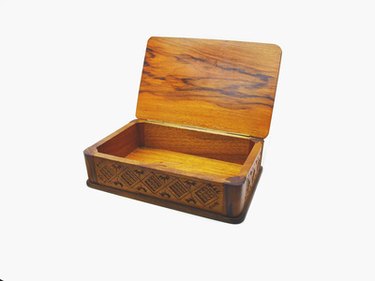Things You'll Need
Two ½-by-3-by-12-inch cedar boards
Two ½-by-3-by-6-inch cedar boards
Wood glue
Two bar clamps
Damp rag
Drill
1/16-inch pilot hole drill bit
Screwdriver
Eight round head wood screws
Two ½-by-3-by-7-inch cedar boards
Two hinges with screws
Tape measure
Small knob with screw
Spring-loaded lid support with screws
120-grit sandpaper
Wood finish
Six felt pads

A small wood chest can hold anything from jewelry to spare keys to small trinkets. Wood chests are great for placing on a stand in a guest room. A guest will welcome the space to place the contents of his pockets before retiring for the evening. Place a wood chest on the hallway table. It would be a useful place to store stationery for quick notes. In the kitchen a small wood chest could hold treasured family recipes. There are many uses for these small chests, but all of them will help you stay organized.
Step 1
Lay out the two side boards parallel to each other on a work surface. Place the two end boards between them. Apply a bead of wood glue to the surfaces where the edges will meet on each of the boards. Put the boards tightly together to form a box. Clamp the boards together. Wipe off any excess glue with a damp rag. Allow the glue to dry for the specified amount of time on the glue bottle. Take the clamps off. Sand all of the surfaces with 120-grit sandpaper.
Video of the Day
Step 2
Use a drill and 1/16-inch pilot hole bit to drill from the sides into the ends 1 inch from the bottom and top of the side boards on both the front and back side of the box. Screw the eight round head wood screws into each of the holes with a screwdriver.
Step 3
Lay one of the ½-by-3-by-7-inch cedar boards flat on the work surface. Apply a bead of glue along the bottom edge of the box assembly. Set the box assembly on top of the ½-by-3-by-7-inch cedar board. Make sure the edges are flush on all sides. Clamp and allow to dry. Wipe off any excess glue with a damp rag. Remove the clamps and sand the glued seams with 120-grit sandpaper to clean off any remaining glue residue.
Step 4
Lay the last ½-by-3-by-7-inch cedar board on the work surface. Place the hinges on the back edge of the board 3 inches in from each end of the board. Use a screwdriver to screw the hinges in place. Place the spring loaded lid support 2 inches in from the left side of the board. Screw it into place with a screwdriver.
Step 5
Flip the board over. On the side opposite the hinges, measure and mark the center of the board. Place the small knob 1 inch in from the edge in line with the center mark. Screw the knob in place. Place the lid on top of the box assembly. Line up the edges. Lift the lid up and mark where the screw holes on the hinges sit on the inside of the back side of the box assembly. Drill a 1/16-inch pilot hole for each of the screws. Place the lid back on the box assembly and line up the hinge screw holes. Screw the hinges in place. Screw the remaining part of the spring-loaded lid support to the box.
Step 6
Lightly sand the entire box with 120-grit sandpaper. Apply a wood finish of your choice. Follow the instructions on the wood finish container. Allow the chest to dry according to provided instructions. Lift the lid of the chest. On the bottom of the lid's outside corners place one felt pad. Close the lid. Flip the chest over. Place one felt pad in each of the chest's four corners.
Tip
Use different types of wood finishes to achieve many different looks from the same wood chest design.
Warning
Always wear safety glasses while woodworking. Follow tool safety precautions carefully.
Video of the Day